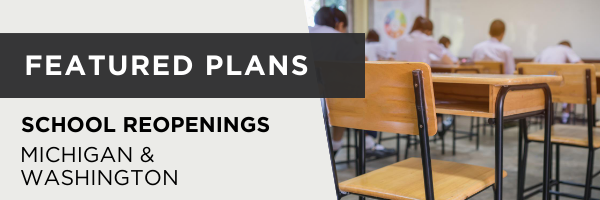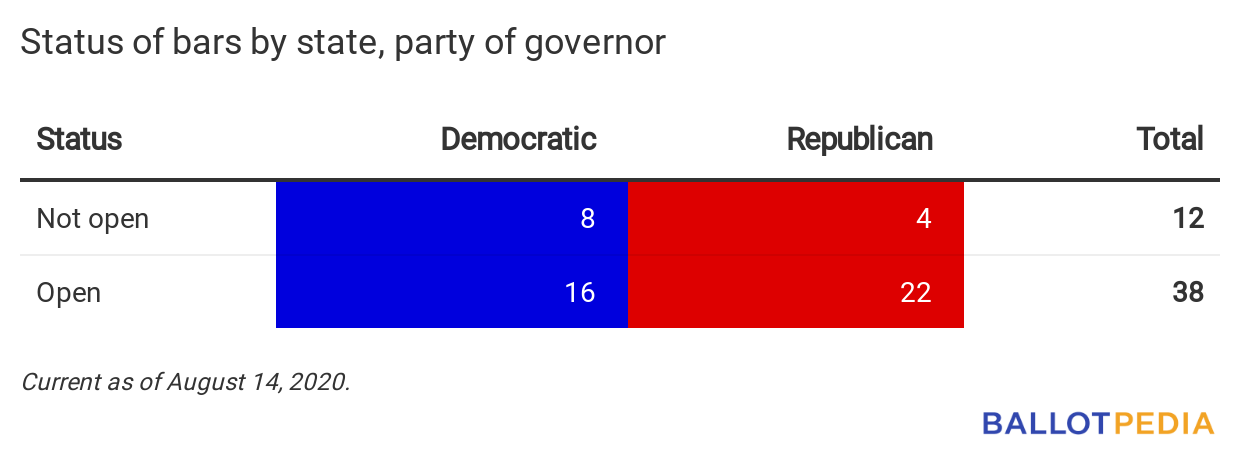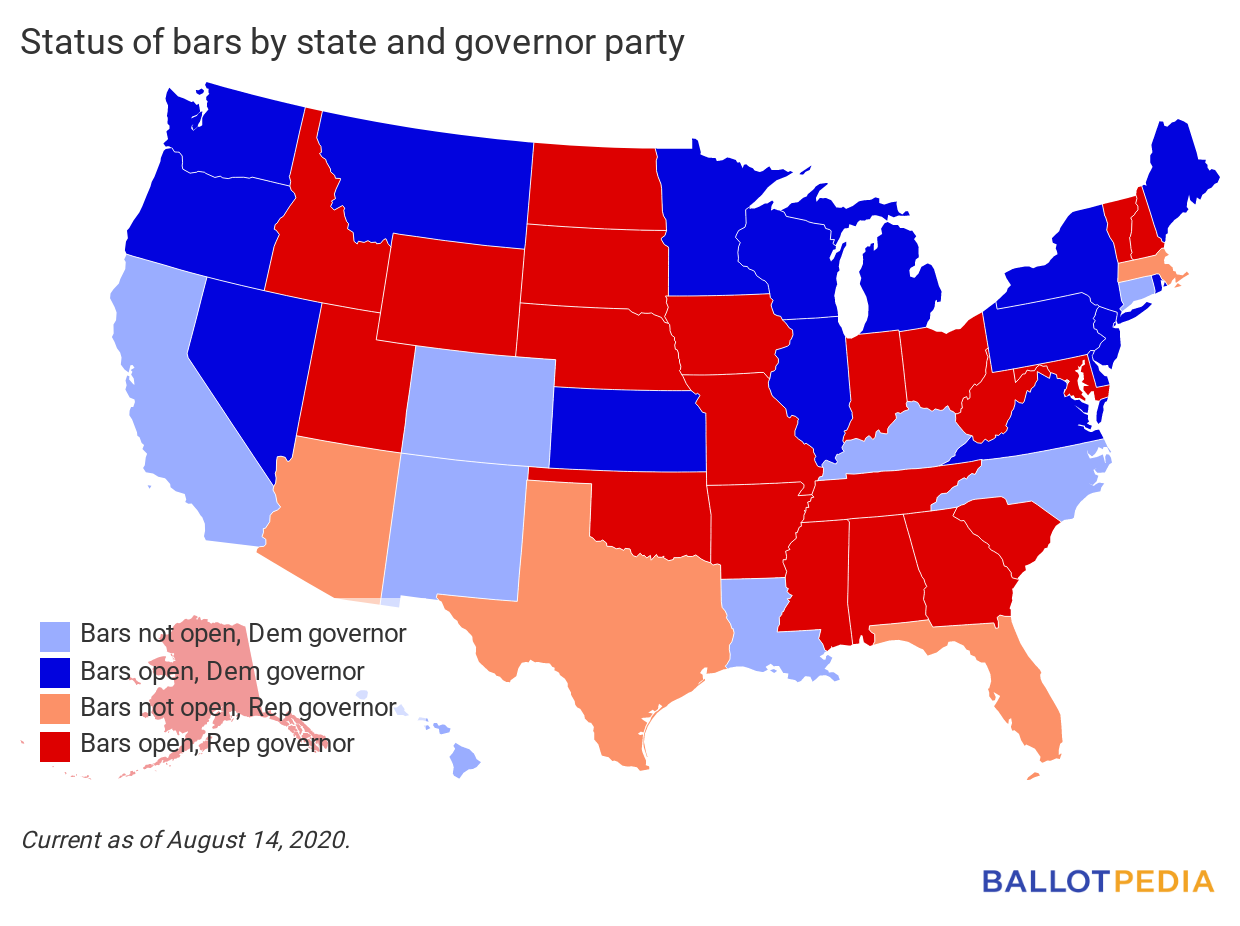Each day, we:
Want to know what happened yesterday? Click here. The next 72 hoursWhat is changing in the next 72 hours?
Since our last editionWhat is open in each state? For a continually updated article on reopening status in all 50 states, click here. For our last edition, click here.
Tracking industries: BarsAll 50 states are reopening in some way. Here, we give the status of one industry or activity across the states. Today’s question: in which states may you go out for a drink? We last looked at bars in the August 7th edition of the newsletter. Since then, no states have opened or closed bars. At an Aug. 13 news conference, Texas Gov. Greg Abbott (R) said he would need to see hospital capacity increase and the state’s positivity rate fall below 10% for a “sustained period of time” before he would consider reopening bars.
|
|||||||||||||||||||||||||||||||||||||||||||||||||||||||||||||||||||||||||||||||||||||||||||||

This is an in-depth summary of two state plans to reopen public K-12 schools for the 2020-2021 school year. Michigan’s Safe Schools Return to School RoadmapOn June 30, Gov. Gretchen Whitmer (D) and the state’s Return to School Advisory Council released the Safe Schools Return to School Roadmap, a list of guidelines for reopening Michigan’s public schools for fall 2020. Whitmer said, “Thanks to our aggressive action against this virus, the teachers who have found creative ways to reach their students, and the heroes on the front lines, I am optimistic that we will return to in-person learning in the fall. The MI SafeSchools Return to School Roadmap will help provide schools with the guidance they need as they enact strict safety measures to continue protecting educators, students, and their families.” On June 25, the Michigan Education Association (MEA) outlined its priorities for reopening schools in the fall, emphasizing safety, meeting diverse student needs, and increased funding. MEA President Paula Herbart said, “We owe it to our students to do everything in our power to return to school in the fall — but only if we can keep them, their families and the school employees who serve them safe. No one has a crystal ball about how this ongoing pandemic is going to unfold, but we can come up with minimum requirements needed to move forward with in-person learning.” Michigan does not have a statewide date for public schools to reopen—individual districts that meet the state’s requirements can set their own timelines. According to EdWeek, public schools in Michigan traditionally start the academic year after Labor Day, with the exact start date varying by district. On March 12, Whitmer closed all schools in the state until April 5. On April 2, Whitmer announced that schools statewide would remain closed for the rest of the academic year. ContextMichigan has a divided government. The governor is a Democrat, and Republicans have majorities in both chambers of the state legislature. The state has had a divided government since 2019. The following tables show public education statistics in Michigan, including a rank comparing it to the other 49 states. Rank one is the highest number of each figure, rank 50 is the lowest. All data comes from the Common Core of Data provided by the National Center for Education Statistics.
DetailsDistrict reopening plans Individual districts are responsible for developing their own reopening plans. Districts were required to file their plans with the state. Chalkbeat Detroit published a list of district reopening plans here. In-person, hybrid, and online learning The state’s school reopening plan closely follows the state’s economic reopening plan, linking specific policies for schools to the phase of economic reopening in that district. The plan outlines four scenarios for instruction during the economic reopening:
Mask requirements Depending on the phase of reopening in a district, there are different requirements for wearing masks or facial coverings. If the district is in Phase Four of the state’s reopening, all students and staff are required to wear facial coverings. In Phase Five, facial coverings are strongly recommended for all. In Phase Six, no facial covering recommendations are made. In-person health recommendations and requirements In Phase Four of the reopening plan, all students, staff, and visitors must take a health screening before entering the building, and all desks must be placed at least six feet apart. Indoor assemblies are limited to those with no more than one class. Meals are recommended to be staggered and taken in outdoor spaces to allow for six feet of social distancing. Off-site field trips are also suspended in this phase, and recess is recommended to be done outdoors with one class. If more than one class is at recess, the state recommends all students wear facial coverings. In Phase Five, most of the requirements from Phase Four become recommendations. The plan emphasizes promoting social distancing to the greatest degree possible and recommends moving desks to allow six feet of distance. Gatherings like recess or assemblies should comply with executive orders about gathering sizes and should stress social distancing. Field trips are permitted, but facial coverings are required for transportation to and from the field trip site. In Phase Six, safety protocols are no longer required. In all phases, if a student or staff member shows symptoms of COVID-19, they are required to isolate and obtain a test. If a student or staff member tests positive, the guidelines require that student to isolate until they have a negative test or have quarantined for the amount of time outlined by the CDC. In the case of a positive test, those who were in close contact with the positive individual are recommended to quarantine and get a test. Transportation and busing requirements and restrictions In Phase Four of the state’s reopening plan, students and staff are required to wear masks and use hand sanitizer upon entering the bus. In Phase Five of the plan, facial coverings are strongly recommended on the bus. In Phase Six, safety protocols are no longer required on buses or transportation. ResponsesMichael Rice, state Superintendent of Instruction, praised the guidelines for return, saying, “This is a thoughtful set of parameters under which we can return safely and realistically to school in the fall. If we follow our health protocols, both inside school and out, we have the opportunity to stay in school longer next school year than if we assume that the pandemic has run its course. It hasn’t.” MEA President Paula Herbart expressed concern for teacher and student safety in school reopening plans, saying in a video to teachers on July 22, “If medical experts say it’s not safe for us to return to buildings to teach students face-to-face, then we can’t and we won’t. If school districts are keeping you and your members out of the process, making decisions about returning to school that don’t include you, and are ignoring you at the bargaining table, then they’ll see us in court.” Washington’s Reopening Washington Schools 2020On June 11, Washington Superintendent of Public Instruction Chris Reykdal released Reopening Washington Schools 2020, a guidance document developed by the Reopening Washington Schools 2020 Workgroup with health and safety recommendations from the state Department of Health. Gov. Jay Inslee (D) said, “We all want students back in educational settings, but we must continue to monitor health data carefully, and proceed with caution. This virus is unpredictable and has upended our regular ways of doing everything. Therefore, if COVID cases spike or spread, we may need to reassess this plan. We cannot guarantee that school will open in fall. But for now, this guidance provides a path that schools, educators and families need to plan for the coming months and the fall. Kids need to be learning but they also need to be safe and healthy.” Washington does not have a statewide date for public schools to reopen—individual districts that meet the state’s requirements can set their own timelines, depending on conditions in their community. According to EdWeek, public schools in Washington traditionally start the academic year in late August to early September, with the exact start date varying by district. On March 13, Inslee ordered all K-12 schools in the state to close for six weeks, effective March 17. On April 6, Inslee closed schools for the remainder of the academic year. ContextWashington has a Democratic trifecta. The governor is a Democrat, and Democrats hold majorities in both chambers of the state legislature. The state became a Democratic trifecta in 2017. The following tables show public education statistics in Washington, including a rank comparing it to the other 49 states. Rank one is the highest number of each figure, rank 50 is the lowest. All data comes from the Common Core of Data provided by the National Center for Education Statistics.
DetailsDistrict reopening plans Districts are required to develop their own reopening plans which must be approved through a local board resolution. Districts then must file their plans with the Office of the Superintendent for Public Instruction and the State Board of Education within two weeks of the district’s fall starting date. In-person, hybrid, and online learning Individual districts are responsible for developing a schedule for returning to school. The guidance document specifies that alternative and hybrid schedules are to be implemented only if social distancing and other health requirements cannot be met:
Mask requirements Students, volunteers, or guests must wear cloth face coverings at school. Students are permitted to use face shields rather than a cloth covering. Staff are required to wear face coverings unless they are working alone. In-person health recommendations and requirements Physical distancing of at least six feet is required in schools, but how to achieve that is left to individual districts. The guidance document says that in addition to keeping students in cohorts, districts should, “practice physical distancing (six feet) within each group of students as much as possible. Create space between students and reduce the amount of time they are close with each other. Your ability to do this will depend on students’ ages and developmental and physical abilities.” The document also recommends limiting the number of students in common spaces, such as cafeterias, and suggests holding lunch periods outside when possible. This may also be done “through meal delivery to classes, or through grab-and-go services. If using the cafeteria, have students sit with their class or group, and ensure physical distance between students and between groups.” If a student or staff member shows symptoms of COVID-19, districts are advised to “separate the person away from others, with supervision at a distance of six feet, until the sick person can leave.” In the case of a positive COVID-19 test, “the local health jurisdiction will advise, but it is likely that many of the student’s classmates will be considered close contacts and need to be quarantined for 14 days.” Transportation and busing requirements and restrictions Schools are required to develop a system for drop-off and pick-up that keeps families at least six feet from each other and reduces their need to enter the school. For school buses and transportation, the guidelines require that districts:
ResponsesOn July 27, the Washington Education Association posted a statement to its website calling for Inslee to mandate fully virtual reopening of public instruction. The statement read, in part, “We know that in-person teaching and learning is best for both students and educators, and educators want nothing more than to get back into schools with our students. The reality is that, with very few exceptions, we are nowhere close to containing the spread of this virus and nowhere close to being able to guarantee the health and safety of our students, educators, families, and communities. Therefore, we cannot responsibly support a return to school buildings for in-person learning this fall. We call on Governor Inslee to continue leading with science and safety and declare that schools will open remotely this fall.” Additional activityIn this section, we feature examples of other federal, state, and local government activity, as well as influencers relevant to recovering from the pandemic.
|
|||||||||||||||||||||||||||||||||||||||||||||||||||||||||||||||||||||||||||||||||||||||||||||
Documenting America’s Path to Recovery: August 14, 2020
By



